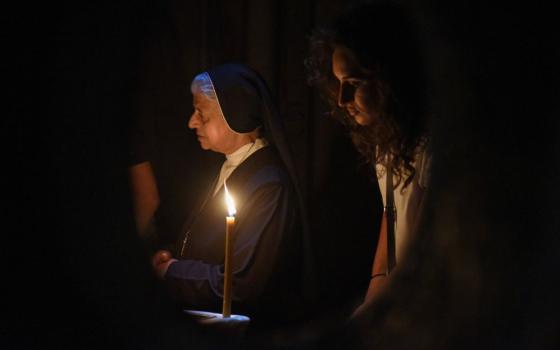When I was little I couldn't wait until I was old enough to participate in the various liturgical rituals during Holy Week. Processing in the choir on Holy Thursday singing "Pange Lingua," attending the Good Friday three-hour ritual in the afternoon, and waiting all day Saturday until midnight to celebrate the Easter Vigil.
Perhaps most memorable was going into our church on Saturday, when the lights were low with few vigil lights burning, and very few distractions. I can still feel the silence that welcomed me. I brought my prayer book with me, but I spent time just sitting there taking in the stillness.
How I understood what was happening was certainly framed in pre-Vatican II theology. This Triduum was to remember the last days of the life of Jesus, who had to suffer and die for our sins so that we could be saved.
Since Vatican II, I have read and studied much. As the insights became integrated into my prayer, they opened up my understanding of faith and spirituality. I came to realize that there is much more to Jesus's life than a "rescue mission," to use Cynthia Bourgeault's words.
Jesus came to offer us a way of being and living in the world that transcended his time. His life and message reflected a worldview that was complex and inclusive, embraced diversity, and understood that with our differences we are one.
In today's language, Jesus' consciousness was developed to a much more complex level than most of the people of his time and even today. Through the parables and teachings of Jesus, we witness behaviors which challenged the norms and laws of his day.
He looked at everyone as worthy of encounter, from the lepers exiled in caves to prostituted women. The sick, the maimed, those who could not see, hear or speak he called to be in relationship with him, to share the healing power of love, forgiveness and mercy. Sadly, Jesus' message was too radical and different from what most people were capable of understanding.
As time went by, the teachings were codified in more palatable language, interpreting his message in ways familiar to how people saw the world and expected God to act. These eclipsed Jesus' more radical way of seeing the world. Perhaps that is why G.K. Chesterton wrote: "Christianity has not been tried and found wanting; it has been found difficult and not tried."
As I reflect on what is happening in our world and our country today, I feel that the vision of Jesus is needed more than ever. We have to try to live Christianity in the heart of societies shaped by technology, science, cosmology, developmental psychology, artificial intelligence and so much more.
We have to try to live Christianity in the heart of the influences of post-modernity, the deconstruction of truth and long-held meta theories, pluralistic democracy, consumerism, and new understandings of sexuality and gender.
We have to try to live Christianity in the heart of the divisions growing among us with less and less tolerance for the "other," increased addiction to violence, rigidity of thought and disregard for the common good.
Jesus was a teacher. All those who chose to follow him were invited to see things differently. To wake up to what is really there. To remove the blinders that keep us seeing through the worldviews and assumptions of an earlier stage of consciousness. To become aware of one's own biases and behaviors so as to enter into the process of transformation. To enter into the process of putting on the mind of Christ.
For me, that is the invitation to contemplation. Although as a child I never called what I did when I sat in the stillness of the church "contemplation," I do believe it was teaching me that silence and stillness are necessary friends for the spiritual journey. Taking time to "just pray" is an active response to what is happening in our life and in our world.
Holy Week is a solemn time to take time. I'd invite you to make sitting in contemplation a priority during these days leading up to and following Easter. Schedule your sitting time before you enter into the rituals so that you can "see" and "hear" anew the readings and reflections. Trust that as you empty yourself in the quiet of sitting, over time new insights will awaken in you as you enter the mystery of God made flesh living and dying among us.
Remember, simply find a quiet space. Get in touch with whatever practice you will use to return to the contemplative space as your mind wanders aimlessly around. This can be either through attention to your breath/mantra or using a sacred word to be your touchstone to let go and release those thoughts. When you are ready set the intention to be open to the working of the Divine within you. Then sit for 20-30 minutes.
I found a very interesting definition of sin attributed to the French writer, Georges Bernanos. He described sin as that patterned way of being in which we remain living at the surface. Perhaps that is how we have been living Christianity — at the surface.
Jesus lived and died to show us another way. To invite us to transformation. Contemplation is a practice that invites us to dive deep and put on the mind of Christ. If sin is living at the surface of who we really are, then this is a rescue mission I can believe in.
[Nancy Sylvester, IHM, is founder and director of the Institute for Communal Contemplation and Dialogue iccdinstitute.org. She served in leadership of her own religious community, the Sister Servants of the Immaculate Heart of Mary, Monroe, MI. ihmsisters.org as well as in the Presidency of the Leadership Conference of Women Religious. Prior to that she was National Coordinator of NETWORK, the national Catholic social justice lobby.]
To read Nancy Sylvester's entire series, click on her author name above or click here to see a list of her columns.

